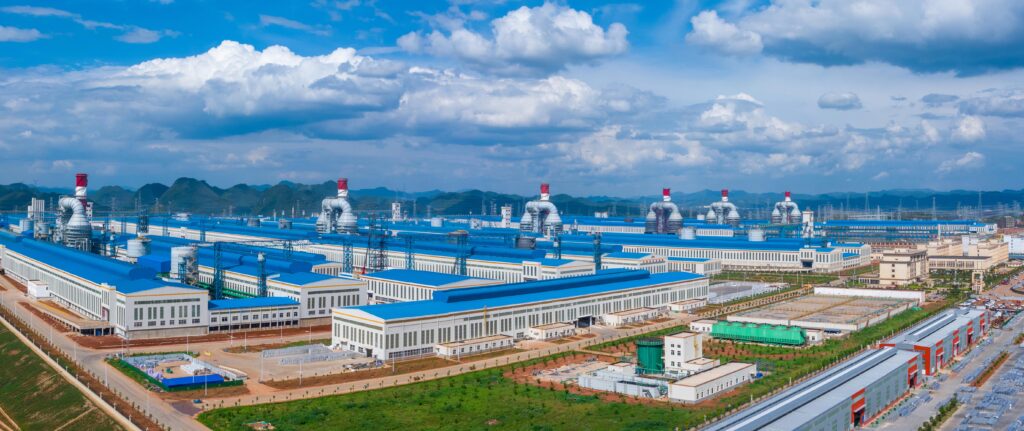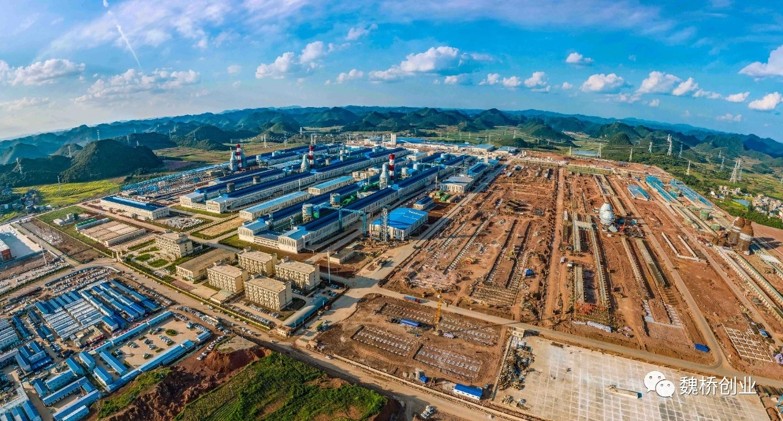China Hongqiao Group
China Hongqiao Group is moving over 60% of its aluminium production from coal-based Shandong to renewables-rich Yunnan Province to accelerate its major decarbonisation strategy.
China Hongqiao Group, one of the world’s largest aluminium producers, is shifting over 60% of production from coal-reliant Shandong to renewables-rich Yunnan province. This structural relocation is reshaping its operations and accelerating its decarbonisation journey. The scale of the transformation and its successful delivery illustrate how corporate strategy and national policy can drive deep emissions cuts in one of the highest- emitting industrial sectors.
| KEY FACTS | |
|---|---|
| Official project name | China Hongqiao Group relocation strategy |
| Location | Yunnan Province, China |
| Project stage | Operating and under construction |
| Sector | Aluminium |
| Capacity | 2.03 million tonnes (Mt) of primary aluminium for Yunnan Hongtai smelter (operating) and 1.93 Mt for Yunnan Honghe smelter (final construction phase being completed) |
| Key milestones | • Yunnan Hongtai smelter groundbreaking ceremony in December 2019 • First metal produced from Yunnan Hongtai in September 2020 • 2025 completion of a 2 GW PV project to complement the Yunnan grid and a further 60 MW rooftop PV plant at the Yunnan Hongtai complex • Commissioning of Yunnan Honghe’s first production line in July 2025 |
Relocation to Yunnan
China Hongqiao was historically based in Shandong Province where coal-powered electricity accounted for 85 to 90% of its emissions. Since 2019, the company has pursued an ambitious relocation strategy, moving smelting capacity to renewable-rich Yunnan Province.
By 2025, approximately 2 Mt of capacity has been relocated, with another 2 Mtpa expected by 2026. The Yunnan Hongtai and Yunnan Honghe greenfield complexes will together represent 3.96 Mt of capacity, nearly two-thirds of the company’s total 6.46 Mt capacity under China’s national 45 Mt primary aluminium production cap. When fully developed, this will be equivalent to the total North American aluminium production.
The move is driven primarily by access to low-carbon energy. While Hongqiao will rely on Yunnan’s grid that is more than 90% renewable, the company has also proactively installed 2 GW of solar capacity in the region in 2025, with an additional 2 GW currently under development.
Efficiency and technology
Relocation has enabled Hongqiao to further modernise its technology base. The new smelters in
Yunnan include advanced Weiqiao NEUI600kA Plus potline technology, which achieves energy
consumption levels below 12.4 MWh per tonne of aluminium, among the lowest globally. The
decarbonisation efforts have already reduced total annual emissions for China Hongqiao by
about five million tonnes of CO2 in 2024 compared with 2020, while increasing production by
over 600,000 tonnes during the same period. The smelter modernisation means the company’s
average smelter age is under 10 years, reflecting a continuous improvement philosophy.
This was an opportunity to refresh our technology along with the access to
low-carbon energy – and it’s almost like starting again with a very modern plant.
— Ron Knapp
Senior Adviser to the Chairman/ CEO of China Hongqiao Group
Cluster development model
Since entering the aluminium industry in 2001 in Shandong Province, China Hongqiao’s cluster
approach, as a core business model, co-locates suppliers and customers near smelters,
allowing direct delivery of hot molten aluminium to customers and eliminating the need for
casting and remelting. This further reduces energy use and cuts emissions. The combined
Shandong and Yunnan operations deliver over 90% of smelter production as hot molten metal.
The Yunnan complexes replicate this model, fostering industrial synergies and enabling rapid
growth of downstream operations.
Financing and execution
The relocation and new energy investments are financed on China Hongqiao’s balance sheet, backed by strong profitability and shareholder commitment. The company maintains a debt-to-equity ratio of approximately 49% and recent years have been highly profitable, enabling reinvestment in strategic projects.
For such transformative projects, you have to have the shareholder commitment and China Hongqiao has been financially very strong. You cannot achieve these decarbonisation goals without financial strength.
— Ron Knapp
Senior Adviser to the Chairman/ CEO of China Hongqiao Group
Execution speed has been remarkable. The Yunnan Hongtai smelter ground-breaking occurred
in December 2019 – and first aluminium was produced before the end of 2020; production
reached 1.5 Mt in 2024 – and 2025 production is expected to be around 1.8 Mt. The first China
Hongqiao PV project in Yunnan involved 19 separate sites in mountainous terrain totaling 2 GW
and construction was completed in under two years.


The ability and the speed of delivery of renewable energy projects in China is one of the advantages we have.
— Ron Knapp
Senior Adviser to the Chairman/ CEO of China Hongqiao Group
Policy alignment and motivation
The strategy supports China’s dual carbon goals of peak emissions by 2030 and net zero by 2060. China Hongqiao aims to meet these targets five years early and reach net zero by 2055. This commitment is deeply embedded in the company’s leadership and shareholder structure,
enabling decisive action and long-term planning.
China’s national carbon market expansion – including to the aluminium sector – and the
upcoming introduction of the EU’s Carbon Border Adjustment Mechanism (CBAM) mean China
Hongqiao is set to maintain a competitive market position.
Building more value
With China’s 45 Mt cap on primary aluminium production, growth must come from value-added
products and circular economy initiatives. At its base in Binzhou in Shandong Province, the
company is investing in downstream operations, lightweight vehicle components, vehicle
disassembly and recycled aluminium processing to support this shift.
China Hongqiao and Germany’s Scholz Group have jointly established the Sino-German
Hongshun Recycling Technology Park in Binzhou, covering multiple industry chains, including
the recycling of scrapped vehicles, and the reuse of recycled aluminium. It has been put into production step by step since May 2022. Each tonne of recycled aluminium saves 95% of energy and reduces carbon emissions by more than 85%.
Future Outlook
Beyond 2026, Hongqiao is expected to continue optimising its energy mix and exploring new
technologies. The company is developing a 500 MW molten salt storage facility to complement
its renewable energy portfolio. It is also engaged in R&D partnerships, including with the Chinese
Academy of Sciences, to advance technological innovation in lightweight materials.
The beauty of China Hongqiao is the capability of the company to be moving on so many fronts and to deliver.
— Ron Knapp
Senior Adviser to the Chairman/ CEO of China Hongqiao Group
China Hongqiao’s Yunnan relocation strategy exemplifies how industrial decarbonisation can be
achieved through bold investment, policy alignment, and technological innovation. It reflects a
broader movement from the Chinese aluminium industry seeking to transfer part of its capacity
in renewable-rich regions. By combining low-carbon energy access with modern smelting
infrastructure and a cluster-based business model, China Hongqiao is setting a benchmark for
clean aluminium production combined with competitive results in China and globally.

